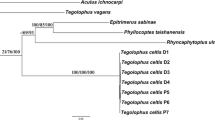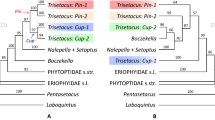Abstract
Hazelnut big bud mite, Phytoptus avellanae Nalepa, is one of the most harmful pests of Corylus spp. (Corylaceae) worldwide. Herein, we show that this species represents a complex of two cryptic species: one that lives and reproduces in buds causing their enlargement (‘big buds’) and drying, whereas the other is a vagrant living on leaves, under bud scales and in catkins, based on phylogenetic analyzes of mitochondrial cytochrome c oxidase subunit I (COI) DNA and the nuclear D2 region of 28S rDNA sequences. A molecular assessment based on mtCOI DNA and nuclear D2 28S rDNA revealed consistent differences of 16.8 and 3.5 % between the two species, respectively. Molecular analysis also revealed that atypical flattened nymphs (Tegonotus-like nymphs sensu Keifer in Mites Injurious to Economic Plants, University of California Press, Berkeley, pp 327–562, 1975) with differently annulated opisthosoma, which appear in the life cycle of P. avellanae s.l., belong to the ‘vagrant’ lineage, i.e. vagrant cryptic species. Light microscopy images of Tegonotus-like nymphs molting into males and females are presented for the first time. Our results suggest that the name P. avellanae comprise two species. Big bud mite should keep the name P. avellanae, and the vagrant cryptic species should be re-named after a proper morphological description is made.





Similar content being viewed by others

Notes
In our opinion it is more appropriate to call this nymph Sierraphytoptus-like because besides the differently annulated opisthosoma it possesses ve and c1 and belongs to the family Phytoptidae.
References
Amrine JW Jr, Stasny TA (1994) Catalog of the Eriophyoidea (Acarina: Prostigmata) of the world. Indira Publishing House, West Bloomfield
Amrine JW Jr, Stasny TA, Flechtmann CHW (2003) Revised keys to world genera of Eriophyoidea (Acari: Prostigmata). Indira Publishing House, West Bloomfield
Bickford D, Lohman DJ, Sodhi NS, Ng PKL, Meier R, Winker K, Ingram KK, Das I (2007) Cryptic species as a window on diversity and conservation. Trends Ecol Evol 22:148–155
Castagnoli M, Oldfield GN (1996) Other fruit trees and nut trees. In: Lindquist EE, Sabelis MW, Bruin J (eds) Eriophyoid mites: their biology, natural enemies and control. World Crop Pests 6. Elsevier, Amsterdam, pp 543–559
Chetverikov PE, Petanović R, Sukhareva SI (2009) Systematic remarks on eriophyoid mites from the subfamily Phytoptinae Murray, 1877 (Acari: Eriophyoidea: Phytoptidae). Zootaxa 2070:63–68
Chetverikov PE, Beaulieu F, Cvrković T, Vidović B, Petanović RU (2012a) Oziella sibirica (Acari: Eriophyoidea: Phytoptidae), a new eriophyoid mite species described using confocal microscopy, COI barcoding and 3D surface reconstruction. Zootaxa 3560:41–60
Chetverikov PE, Cvrković T, Vidović B, Petanović R (2012b) Phylogenetic study of Phytoptidae (Acari, Eriophyoidea) based on mitochondrial COI sequence strongly support the division of the genus Phytoptus into two groups. In: Abstracts of the 7th symposium of the European Association of Acarologists 9–13 July 2012, Vienna, Austria, p 80
Chetverikov PE, Cvrković T, Vidović B, Petanović RU (2013) Description of a new relict eriophyoid mite, Loboquintus subsquamatus n. gen. & n. sp. (Eriophyoidea, Phytoptidae, Pentasetacini) based on confocal microscopy, SEM, COI barcoding and novel CLSM anatomy of internal genitalia. Exp Appl Acarol 61:1–30
Chetverikov PE, Cvrković T, Makunin A, Sukhareva S, Vidović B, Petanović R (2015) Basal divergence of Eriophyoidea (Acariformes, Eupodina) inferred from combined partial COI and 28S gene sequences and CLSM genital anatomy. Exp Appl Acarol 67:219–245
Hebert PDN, Cywinska A, Ball SL, deWaard JR (2003) Biological identifications through DNA barcodes. Proc R Soc Lond B 270:596–599
Heinze K (1952) Polyvinylalkohol-Lactophenol-Gemisch als Einbettungsmittel für Blattläuse. Naturwissenschaften 39:285–286
Huelsenbeck JP, Ronquist F (2001) MRBAYES: Bayesian inference of phylogenetic trees. Bioinformatics 17:754–755
Keifer HH (1940) Eriophyid studies IX. Bull Calif Dep Agr 29:112–117
Keifer HH (1975) The Eriophyoidea Nalepa. In: Jeppson LR, Keifer HH, Baker EW (eds) Mites injurious to economic plants. University of California Press, Berkeley, pp 327–587
Krantz GW (1974) The role of Phytocoptella avellanae (Nal.) and Cecidophyopsis vermiformis (Nal.) in big bud of filbert. In: Proceedings of the 4th international congress of acarology, pp 201–208
Lewandowski M, Skoracka A, Szydło W, Kozak M, Druciarek T, Griffiths DA (2014) Genetic and morphological diversity of Trisetacus species (Eriophyoidea: Phytoptidae) associated with coniferous trees in Poland: phylogeny, barcoding, host and habitat specialization. Exp Appl Acarol 63:497–520
Martin P, Dabert M, Dabert J (2010) Molecular evidence for species separation in the water mite Hygrobates nigromaculatus Lebert, 1879 (Acari, Hydrachnidia): evolutionary consequences of the loss of larval parasitism. Aquat Sci 72:347–360
Massee AM (1930) On some species of gall-mites (Eriophyidae) found on Corylus avellana. L. Bull Entomol Res 21:165–168
Nuzzaci G (1976) Contributo alla conoscenza dell’anatomia degli Acari Eriofidi. Entomologica 12:21–55
Nuzzaci G, Liaci LS (1975) Aspetti ultrastrutturali dalla cellula ouvo e delle cellule follicolari di Phytoptus avellanae Nal. (Acarina: Eriophyoidea). Entomologica 11:173–181
Ozman SK (2000) Some biological and morphological differences between gall and vagrant forms of Phytoptus avellanae Nal. (Acari: Phytoptidae). Int J Acarol 26:215–219
Ozman SK, Toros S (1997a) Life cycles of Phytoptus avellanae Nal. and Cecidophyopsis vermiformis Nal. (Acarina: Eriophyoidea). Acta Hortic 445:493–501
Ozman SK, Toros S (1997b) Damage caused by Phytoptus avellanae Nal. and Cecidophyopsis vermiformis Nal. (Eriophyoidea: Acarina) in hazelnut. Acta Hortic 445:537–543
Ozman-Sulivan SK (2006) Life history of Kampimodromus aberrans as a predator of Phytoptus avellanae (Acari: Phytoseiidae, Phytoptidae). Exp Appl Acarol 38:15–23
Ozman-Sulivan SK (2014) Do the contradictory life cycles of the hazelnut big bud mite, Phytoptus avellanae (Nal.) (Acari: Phytoptidae) imply two species? In: Abstract book, XIV International Congress of Acarology, 13–18th, July, 2014, Kyoto, Japan, p 62
Ozman-Sulivan SK, Akça I (2005) Efficiency of pesticides against big bud mites [Phytoptus avellanae Nal. and Cecidophyopsis vermiformis Nal.] (Acarina: Eriophyoidea) on hazelnut. Acta Hortic 686:393–399
Petanović R, Dobrivojević K, Bošković R (1989) Life cycle of hazelnut big bud mite Phytoptus avellanae Nal. (Acarida: Eriophyoidea) and the results of its control. Zašt bilja 40:433–441 (in Serbian)
Posada D, Crandall KA (1998) Modeltest: testing the model of DNA substitution. Bioinformatics 14:817–818
Ronquist F, Huelsenbeck JP (2003) MrBayes 3: Bayesian phylogenetic inference under mixed models. Bioinformatics 19:1572–1574
Skoracka A, Dabert M (2010) The cereal rust mite Abacarus hystrix (Acari: Eriophyoidea) is a complex of species: evidence from mitochondrial and nuclear DNA sequences. Bull Ent Res 100:263–272
Skoracka A, Kuczynski L, Szydło W, Rector B (2013) The wheat curl mite Aceria tosichella (Acari: Eriophyoidea) is a complex of cryptic lineages with divergent host ranges: evidence from molecular and plant bioassay data. Biol J Linn Soc 109:165–180
Sonnenberg R, Nolte AW, Tautz D (2007) An evaluation of LSU rDNA D1–D2 sequences for their use in species identification. Front Zool 4:6
Stamenković S, Milenković S, Pešić M, Mitrović M (1997) Population dynamics, harmfulness and control of Phytoptus avellanae Nalepa in Western Serbia. Acta Hortic 445:521–526
Stevens M, Hogg I (2006) Contrasting levels of mitochondrial DNA variability between mites (Penthalodidae) and springtails (Hypogastruridae) from the Trans-Antarctic Mountains suggest long-term effects of glaciation and life history on substitution rates, and speciation processes. Soil Biol Biochem 38:3171–3180
Sukhareva SI (1994) Family Phytoptidae Murray 1877 (Acari: Tetrapodili), its consisting, structure and suggested ways of evolution. Acarina 2:47–72
Tamura K, Peterson D, Peterson N, Stecher G, Nei M, Kumar S (2011) MEGA5: molecular evolutionary genetics analysis using maximum likelihood, evolutionary distance and maximum parsimony methods. Mol Biol Evol 28:2731–2739
Thompson MM (1977) Inheritance of big bud mite susceptibility in filberts. J Am Soc Hortic Sci 102:39–42
Tsolakis H, Ragusa E, Ragusa Di Chiara S (2000) Distribution of phytoseiid mites (Parasitiformes: Phytoseiidae) on hazelnut at two different altitudes in Sicily (Italy). Environ Entomol 29:1251–1257
Vidal-Barraquer R, Moreno Gil, de Mora J, de Sivatte M, Miquel J (1966) Phytoptus avellanae Nal. and other eriophyids on hazel. Bol Pathol Veg d’Entomol Madrid 29:133–235
Webber J, Chapman RB, Worner SP (2008) Forecasting emergence and movement of overwintering hazelnut big bud mites from big buds. Exp Appl Acarol 45:39–51
Zhang D-X, Hewitt GM (2003) Nuclear DNA analyses in genetic studies of populations: practice, problems and prospects. Mol Ecol 12:563–584
Acknowledgments
This work was partly supported by a research grant of the Ministry of Education, Science and Technological Development of Serbia (Grant # III 43001). Collecting mites in the USA and Russia, work visit of PC to Belgrade University (Serbia) and microscopic studies were supported by the Russian Science Foundation (RSCF grant #14-14-00621) to the second author. We sincerely thank Prof. James W. Amrine (West Virginia University, Morgantown, WV, USA) for collecting samples in North America. Authors are grateful to Prof. Marko Anđelković, academician of SASA who for several years organized surveys of eriophyoids in Tara National Park, Serbia. We would also like to thank Mrs. Dragica Smiljanić and PhD student Mrs. Katarina Mladenović, University of Belgrade, Faculty of Agriculture, Serbia, and Dr. Ivo Toševski and Dr. Jelena Jović, Institute for Plant protection and Environment, Serbia, for collecting part of the samples.
Author information
Authors and Affiliations
Corresponding author
Rights and permissions
About this article
Cite this article
Cvrković, T., Chetverikov, P., Vidović, B. et al. Cryptic speciation within Phytoptus avellanae s.l. (Eriophyoidea: Phytoptidae) revealed by molecular data and observations on molting Tegonotus-like nymphs. Exp Appl Acarol 68, 83–96 (2016). https://doi.org/10.1007/s10493-015-9981-5
Received:
Accepted:
Published:
Issue Date:
DOI: https://doi.org/10.1007/s10493-015-9981-5



